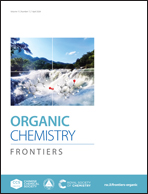Insights into the mechanism and origin of multifunctional ligand effects on chemoselectivity in Pd-catalyzed unnatural prenylation and geranylation of oxindoles with isoprene†
Abstract
Density functional theory calculations were conducted to elucidate the mechanism and the origin of chemoselectivity in Pd-catalyzed unnatural prenylation and geranylation of oxindoles with isoprene. For different mono- and bisphosphine ligands, the isoprenylated C5- or monoterpenylated C10-added oxindole product is selectively majorly formed based on the Pd–H and ligand-to-ligand hydrogen transfer (LLHT) mechanisms. Moreover, the origin of the preferred LLHT mechanism can be ascribed to the C–H⋯O− and C–H⋯π interactions as well as the coordination interaction of the metal palladium and the ligand (Pd⋯O(MeO−)/Pd⋯C![[double bond, length as m-dash]](https://www.rsc.org/images/entities/char_e001.gif) C(olefin)), compared to the only Pd⋯C
C(olefin)), compared to the only Pd⋯C![[double bond, length as m-dash]](https://www.rsc.org/images/entities/char_e001.gif) C (olefin) coordination model in the Pd–H involved mechanism. In fact, these studies unveil the multiple important roles of isoprene and MeOH in the coordination sphere at the Pd center: acting as a reactant and a ligand to tune the coordination geometry of the Pd catalytic center by contributing more favorable electrostatic and dispersion interactions. For the prenylation reaction under Pd and bisphosphine ligand catalysis, the coordination environment of the metal center is changed from the Pd–P double coordination model to Pd–P and Pd–O coordination models, similar to the geranylation reaction for the mono-phosphine ligand in the preferred LLHT mechanism. The origin of product chemoselectivity achieved by switching mono- and bisphosphine ligand effects accompanied by Pd catalysis can be ascribed to the different steric hindrances in catalyst pockets. Overall, our findings can serve as a benchmark for other similar Pd-catalyzed reactions, which might open a new avenue for designing more efficient mono- and bisphosphine ligand-controlled chemoselective reactions.
C (olefin) coordination model in the Pd–H involved mechanism. In fact, these studies unveil the multiple important roles of isoprene and MeOH in the coordination sphere at the Pd center: acting as a reactant and a ligand to tune the coordination geometry of the Pd catalytic center by contributing more favorable electrostatic and dispersion interactions. For the prenylation reaction under Pd and bisphosphine ligand catalysis, the coordination environment of the metal center is changed from the Pd–P double coordination model to Pd–P and Pd–O coordination models, similar to the geranylation reaction for the mono-phosphine ligand in the preferred LLHT mechanism. The origin of product chemoselectivity achieved by switching mono- and bisphosphine ligand effects accompanied by Pd catalysis can be ascribed to the different steric hindrances in catalyst pockets. Overall, our findings can serve as a benchmark for other similar Pd-catalyzed reactions, which might open a new avenue for designing more efficient mono- and bisphosphine ligand-controlled chemoselective reactions.



 Please wait while we load your content...
Please wait while we load your content...